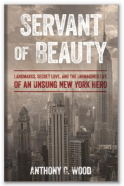Finding a Home for the Tom Killian/Françoise Astorg-Bollack Photo Collection
June 20, 2025
Through our “Saving Papers” initiative, the New York Preservation Archive Project saves archival materials created by historic preservationists and other individuals and groups that tie into New York City’s preservation history. We then work to find long-term homes for them, collaborating with key collecting institutions that make the materials available to researchers and the public over the long term. In the past year, we expanded our work beyond papers into an abundant but often overlooked medium for preservation documentation: slides.
In February 2024, preservation architect Françoise Astorg-Bollack reached out to the Archive Project about finding a suitable home for a robust collection of over 60,000 35mm color Kodachrome slides featuring images of architecture that she and her partner Tom Killian, who passed away in 2024, compiled between 1960 and 2018. Architects Bollack and Killian compiled photographs about buildings, both “high style” and vernacular in all periods. Some of these buildings no longer exist and are not documented anywhere else—like the former Racquet Club or the Art Deco Knickerbocker Laundry in New York City. There are also photographs documenting urban, village, industrial, and other built environment scenes, some ephemeral—graffiti, signage, street art, and the like. The collection is strong in images of New York City, the United States of America, and Western and Northern Europe. Digitized versions of some of the photographs have been published in Bollack and Killian’s books and lectures, but most of these images have never been seen before.
Both Astorg-Bollack and Killian intended for their photographs to be freely available online to students, scholars, and the general public for study and enjoyment—a lofty yet admirable goal given that few collecting institutions have the capacity to scan and store slides. Recognizing this challenge, Archive Project board member Anthony W. Robins recommended a possible collaboration with the Internet Archive, a non-profit library of millions of free texts, movies, software, music, websites, and more dedicated to the mission of providing “Universal Access to All Knowledge.” Archive Project Executive Director Emily Kahn connected with Jeremy Matos-Modell, Away Team Project Manager and Logistics Coordinator at the Internet Archive, to facilitate the transfer, scanning, distribution, and storage of the slides. In April 2024, a team from the Archive Project and the Internet Archive packaged and picked up the slides from Bollack and Killian’s Upper West Side apartment.
Through acquiring the Tom Killian/Françoise Astorg-Bollack Photo Collection with the help of the New York Preservation Archive Project, the Internet Archive has now launched a pilot slides digitization project, Staff from the Internet Archive are scanning and uploading the collection onto the organization’s website using technology that converts the hand-labelled cardboard sleeve on each slide into digital information. Bollack remains active in labelling efforts, hailing the partnership as “an excellent match…because our goals are so perfectly aligned.”
Kahn and Matos-Modell spoke in March 2025 about the ongoing partnership and work on the Tom Killian/Françoise Astorg-Bollack Photo Collection. On the following pages is an edited transcript of that conversation:
Matos-Modell: We haven’t digitized Koda-chrome slides before. I was given permission to try a pilot project for this to see if we can partially automate the digitization and what we can do to try to support it because we do have some collections incidentally, from taking in libraries, where we do have some slides.
Kahn: Why do you think slide digitization is important in this day and age?
Matos-Modell: It’s media that can be lost, honestly. For the Internet Archive, we try to make everything as digital as possible. A large advantage of the organization is that we really try hard for digitization and then we’re able to have backups. We’re able to have it distributed all around.
For these materials, Françoise really wanted them to be educational materials and for them to be searchable. For that they need to live digitally. It’s a unique media. A lot of people have a good deal of them. There isn’t that much digitization of them normally. I know Columbia has done a good amount and the architectural library in Montreal, Canada, has done a good amount. It’s something that’s a bit labor intensive. We want to make sure that the media is preserved, and we think this is a good opportunity to try a new digitization path for us.
Obviously we have the most experience with books. And we digitize 78 RPM records and other media, but it’s a unique opportunity. I think it’s worthwhile because they represent a slice in time, specifically, for these slides in particular, architectural elements that may not exist or have been changed. It’s interesting to see the change over time, and I think there’s certainly educational value in it.
Kahn: Can you talk about the processing work that you’ve been doing and how you developed and executed that protocol?
Matos-Modell: For slides, one of the biggest issues is that there’s metadata written on the cardboard sleeve on the outside. Instead of just taking a picture of one slide and then manually entering in the metadata, I was looking at ways to make it more efficient, to make it so the tagging is all done on the computer rather than by physically picking up the slide. And then looking at ways for AI to help automate the process because Optical Character Recognition (OCR) has gotten quite good for some of these platforms. We’ve experimented with OCR successfully in trying to read the notes and trying to put them into set categories. Right now what we do is we digitize the slide itself, through some off-the-shelf hardware. Then we take an image of many of the slides at once with the cardboard sleeve, and we cut the image up. It’s assigned a number that matches the slide that was digitized. We created this web app and you’re able to tag the slide right on there.
It also gives the recommendations, if it’s been pre-processed by AI, of “this is in Paris, France” or it’s a building by this architect based on the writing on the slide. The idea is that, if there’s not time to tag everything manually, we at least have something there.
That’s been the process thus far. It’s been a little bit of a slow development process, but we wanted to try something new for it. And again, it’s a pilot project. We’ll see how we go forward with this with other slide collections. I know there are some folks at the Internet Archive who are excited about the ability to digitize a different kind of media and to be able to do it efficiently. Kahn: What happens to the slides once you’re done with digitizing them?
Matos-Modell: We store them. Everything that we digitize, that’s unique, we store in our physical facilities. And we store them indefinitely. We hold onto them because we think that physical preservation is very important. It’s the same thing that we do with books. They will be stored. They’ll be safe.
Kahn: What’s your vision for this collection once it’s live and accessible to the public?
Matos-Modell: My hope is that, particularly with tagging, people are able to search for things that may be of interest, specifically era, times, specific cities, and maybe specific architects, that they can use for their educational materials and they can use in classes. I know Françoise indicates that she wants there to be free use with attribution in all academic contexts, so hopefully to support academic work. There’s potential things that we haven’t even thought very much of. If we’re able to get an address or an approximate address, you could even do comparisons on an interactive map because we can geolocate the address, the GPS coordinates on it. So there’s some fun things you can do once it is digital and once it is tagged that I think will be pretty unique. And it’s cool to see the historical photographs like that with this metadata attached to them.
Kahn: And I know Françoise Astorg-Bollack has been involved throughout the process. Can you talk about the work she is doing to help identify the locations and the tagged information?
Matos-Modell: She’s interpreting the notes on the slides themselves, and she is going to be doing the tagging, and she has worked with us to indicate what categories of information are important to store, if possible, about the slides since I am not personally coming to this in an academic context. She’s helped design some of that, but it’ll be a lot of helping with the tagging and improving the process going forward.
Kahn: What would you say to people thinking about doing the daunting task of slides digitization?
Matos-Modell: There’s definitely tooling available to do it that makes it a bit faster than you think. You have to think of what the aims of it are. If the aims are for academic reproduction, that might have somewhat different standards than for a fine art print. In my opinion, a lot of these things are of historic value, of educational value. What you want to do is get as much of it digitized as possible. It’s less so making sure that every step of the way is absolutely perfect as much as you want this to be accessible.
It’s been an interesting project, and we’re doing it in a different way than others have tackled the issue, but I think there’s probably a large demand to digitize these kinds of things. We’ll see how this little pilot program goes forward.
The Internet Archive seeks to preserve all materials, and we do seek donations of materials we don’t have. We actively digitize books. We can be at home for these things, and we store a lot of materials, and we are a good academic resource.
Kahn: I think, in the desire to preserve materials and to ensure public access to them, the Internet Archive and the New York Preservation Archive Project are very much aligned. Hopefully this is just the start of ongoing collaboration to preserve some rare materials in the context of preservation history that keep coming to our attention.
Please stay tuned for updates about the ongoing digitization efforts of the Tom Killian/Françoise Astorg-Bollack Photo Collection


